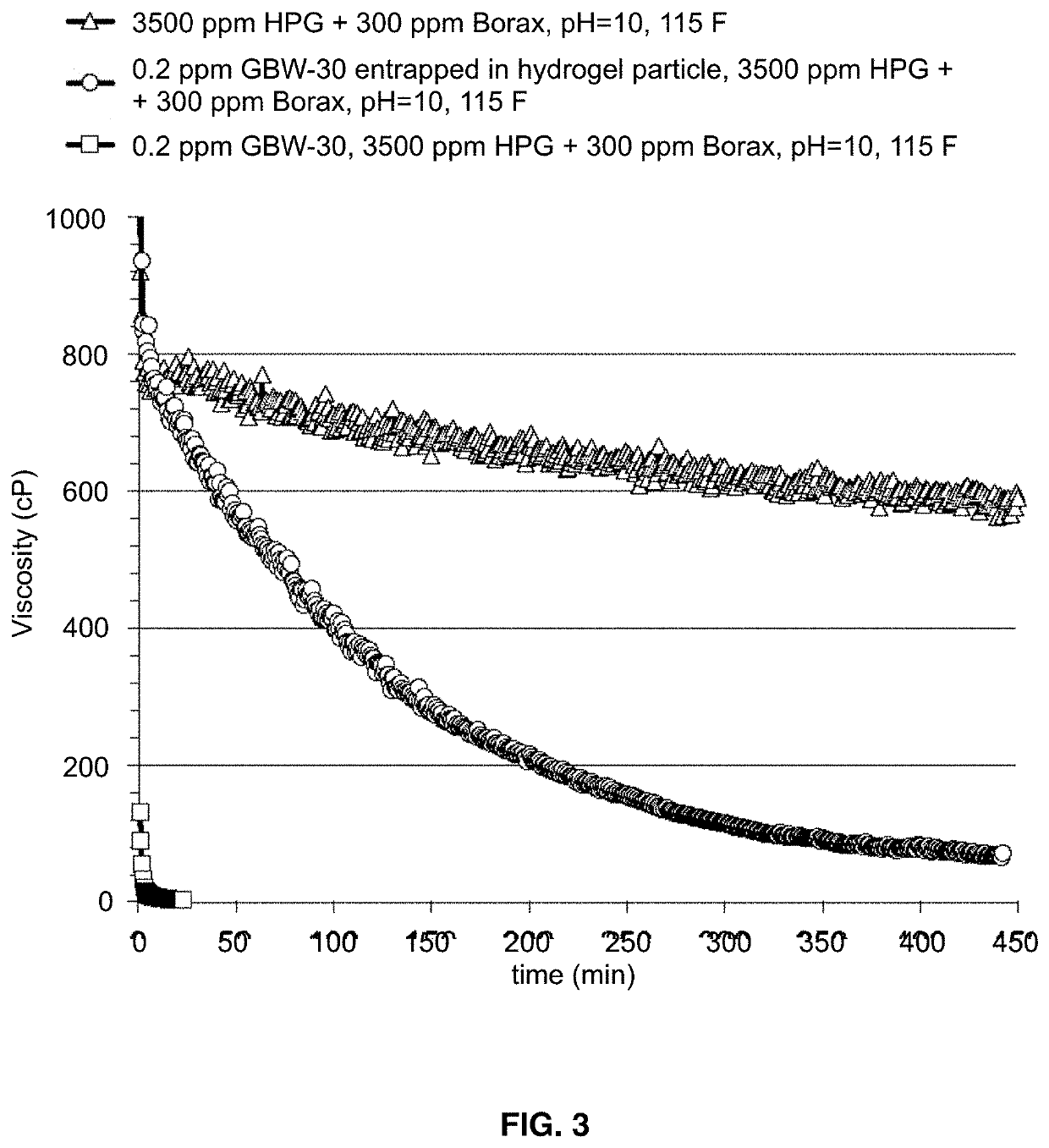Enzyme-Encapsulated Hydrogel Nanoparticles for Hydraulic Fracturing Fluid Cleanup
a technology of hydrogel nanoparticles and hydrogel nanoparticles, which is applied in the field of fracturing technologies, can solve the problems of low post-fracturing well productivity, inefficient fracture creation and incomplete fracture cleanup, and formation damage caused, so as to prevent the premature degradation thereof, and prevent the premature degradation of fracturing fluid
- Summary
- Abstract
- Description
- Claims
- Application Information
AI Technical Summary
Benefits of technology
Problems solved by technology
Method used
Image
Examples
example 1
Characteristics of Enzyme-Encapsulated Hydrogel Nanoparticles
[0037]Enzyme-encapsulated hydrogel nanoparticles with delayed release of enzyme are developed to improve fracturing efficiency and to facilitate effective cleanup of hydraulic fracturing fluids which is critical to the success of hydraulic fracturing in both conventional and unconventional reservoirs.
[0038]The enzyme-encapsulated hydrogel nanoparticles have a number of advantages. For example, the enzymes are 100% encapsulated in hydrogel nanoparticles with no risk of premature breakdown of polymers by unentrapped enzymes. Secondly, enzyme-encapsulated hydrogel nanoparticles may be prepared using simple solution polymerization or inverse-emulsion polymerization methods with no specialized equipment required for commercial-scale production. Thirdly, enzyme-encapsulated hydrogel nanoparticles are very cost-effective with high enzyme loading and low enzyme concentration required for effective fracturing fluid breakdown. Furth...
example 2
Production of Enzyme-Encapsulated Hydrogel Nanoparticles
[0040]Enzyme-encapsulated hydrogel nanoparticles may be made by either inverse-emulsion polymerization or solution polymerization.
Inverse-Emulsion Polymerization
[0041]The synthetic preparation of inverse-emulsion: ultrasonication of mixture of water and oil phases while stirring, removal of oxygen via purging with nitrogen gas for 15 mins and polymerization at 52-55° C. for 2 hours (Table 1). For enzyme-encapsulated hydrogel nanoparticles prepared by inverse emulsion polymerization, a water solution containing enzyme, monomer, and cross-linker is the dispersed phase and an oil solution containing surfactant or co-surfactant is the continuous phase. During field application, enzyme-encapsulated hydrogel nanoparticles are first released into the water solution from the inversed emulsion using an inverting surfactant while stirring. Then the enzyme-encapsulated hydrogel nanoparticles released into the water solution are mixed with...
example 3
Enzyme-Encapsulated Nanoparticles Prevent Premature Polymer or Gel Degradation
[0043]The present invention demonstrated that enzyme-encapsulated hydrogel nanoparticles are effective in preventing HPG polymer or crosslinked HPG gel from premature degradation compared to a free unentrapped enzyme. The enzyme used is GBW-30 C (received from Baker Hughes). GBW-30 C is a very active enzyme capable of breaking 3000 ppm of HPG at a very low concentration (0.2 ppm) at 115° F. (FIG. 2). The enzyme loading in enzyme-encapsulated hydrogel nanoparticles used in the tests was 10,000 ppm, which means that the dilution factor from 10,000 ppm to 0.2 ppm is 50,000. The enzyme is also capable of breaking a strong crosslinked HPG gel (3500 ppm of HPG crosslinked with 200 ppm of Borax) at a low concentration of 0.2 ppm (FIG. 3). With the same enzyme loading of 10,000 ppm, the dilution factor in this case is 50,000. Therefore, the enzyme-encapsulated hydrogel nanoparticles are very cost-effective for hyd...
PUM
| Property | Measurement | Unit |
|---|---|---|
| concentration | aaaaa | aaaaa |
| conductivity | aaaaa | aaaaa |
| particle size | aaaaa | aaaaa |
Abstract
Description
Claims
Application Information
 Login to View More
Login to View More - R&D
- Intellectual Property
- Life Sciences
- Materials
- Tech Scout
- Unparalleled Data Quality
- Higher Quality Content
- 60% Fewer Hallucinations
Browse by: Latest US Patents, China's latest patents, Technical Efficacy Thesaurus, Application Domain, Technology Topic, Popular Technical Reports.
© 2025 PatSnap. All rights reserved.Legal|Privacy policy|Modern Slavery Act Transparency Statement|Sitemap|About US| Contact US: help@patsnap.com


